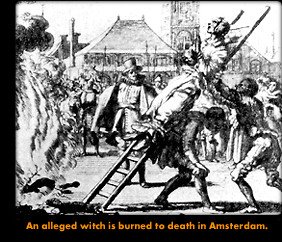Witch Burning
 I watched Bergman's 'The Seventh Seal' recently and was struck with the horror of a witch burning. I've decided to do a sculptural piece depicting this act and it's inhumanity. Some of my research is below.
I watched Bergman's 'The Seventh Seal' recently and was struck with the horror of a witch burning. I've decided to do a sculptural piece depicting this act and it's inhumanity. Some of my research is below.A few notes provided by an Ontario group for religious tolerence:
- The total number of victims was probably between 50,000 and 100,000 -- not 9 million as many believe.
- Although alleged witches were burned alive or hung over a five century interval -- from the 14th to the 18th century -- the vast majority were tried from 1550 to 1650.
- Some of the victims worshiped Pagan deities, and thus could be considered to be indirectly linked to today's Neopagans. However most apparently did not.
- Some of the victims were midwives and native healers; however most were not.
- Most of the victims were tried [and] executed by local, community courts, not by the Church.
- A substantial minority of victims -- about 25% -- were male.
- Many countries in Europe largely escaped the burning times: Ireland executed only four "Witches;" Russia only ten. The craze affected mostly Switzerland, Germany and France.
The website also provides a timeline for the witchhunt phenomenon. Here's an excerpt:
Prior to the 9th century CE: There was a widespread popular belief that evil Witches existed. They were seen as evil persons, primarily women, who devoted their lives to harming and killing others through black magic and evil sorcery. The Catholic church at the time officially taught that such Witches did not exist. It was a heresy to say that they were real. "For example, the 5th century Synod of St. Patrick ruled that 'A Christian who believes that there is a vampire in the world, that is to say, a witch, is to be anathematized; whoever lays that reputation upon a living being shall not be received into the Church until he revokes with his own voice the crime that he has committed.' A capitulary from Saxony (775-790 CE) blamed these stereotypes on pagan belief systems: 'If anyone, deceived by the Devil, believes after the manner of the Pagans that any man or woman is a witch and eats men, and if on this account he burns [the alleged witch]... he shall be punished by capital sentence."
906 CE: Regino of Prum, the Abbot of Treves, wote the Canon Episcopi. It reinforced the church's teaching that Witches did not exist. It admitted that some confused and deluded women thought that they flew through the air with the Pagan Goddess Diana. But this did not happen in reality; it was explained away as some form of hallucination.




0 Comments:
Post a Comment
<< Home